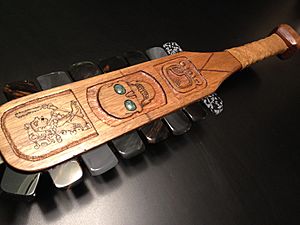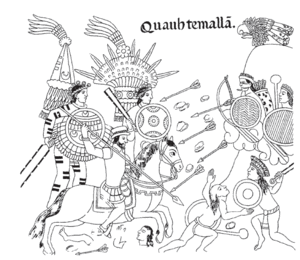Macuahuitl facts for kids
Quick facts for kids Macuahuitl |
|
|---|---|

A modern recreation of a ceremonial macuahuitl
|
|
| Type | Macuahuitl |
| Place of origin | Mexico |
| Service history | |
| In service | Classic to Post-Classic stage (900–1570) |
| Used by | Mesoamerican civilizations, including Aztecs Indian auxiliaries of Spain |
| Wars | Aztec expansionism, Mesoamerican wars Spanish conquest of the Aztec Empire |
| Specifications | |
| Mass | 2.0–3.0 kg (4.4–6.6 lb) |
| Length | 90–120 cm (35–47 in) |
|
|
|
| Blade type | Straight, thick, double-edged, tapered |
| Hilt type | Double-handed swept |
| Scabbard/sheath | Unknown |
| Head type | Trapezoidal |
| Haft type | Straight, wood covered by leather |
A macuahuitl ([maːˈkʷawit͡ɬ]) is a weapon, a wooden club with several embedded obsidian blades. The name is derived from the Nahuatl language and means "hand-wood". Its sides are embedded with prismatic blades traditionally made from obsidian. Obsidian is capable of producing an edge sharper than high quality steel razor blades. The macuahuitl was a standard close combat weapon.
Use of the macuahuitl as a weapon is attested from the first millennium CE. By the time of the Spanish conquest the macuahuitl was widely distributed in Mesoamerica. The weapon was used by different civilisations including the Aztec (Mexicas), Maya, Mixtec and Toltec.
One example of this weapon survived the Conquest of the Aztec Empire; it was part of the Royal Armoury of Madrid until it was destroyed by a fire in 1884. Images of the original designs survive in diverse catalogues. The oldest replica is the macuahuitl created by the medievalist Achille Jubinal in the 19th century.
Contents
Description
The maquahuitl (Classical Nahuatl: mācuahuitl, other orthographic variants include maquahutil, macquahuitl and māccuahuitl; plural macuahuimeh), a type of macana, was a common weapon used by the Aztec military forces and other cultures of central Mexico. It was noted during the 16th-century Spanish conquest of the region. Other military equipment recorded includes the round shield (chīmalli, [t͡ʃiˈmalːi]), the bow (tlahuītōlli, [t͡ɬaʔwiːˈtoːlːi]), and the spear-thrower (ahtlatl, [ˈaʔt͡ɬat͡ɬ]). Its sides are embedded with prismatic blades traditionally made from obsidian (volcanic glass); obsidian is capable of producing an edge sharper than high-quality steel razor blades.
It was capable of inflicting serious lacerations from the rows of obsidian blades embedded in its sides. These could be knapped into blades or spikes, or into a circular design that looked like scales. The maquahuitl is not specifically a sword or a club, although it approximates a European broadsword. Historian John Pohl defines the weapon as a "kind of a saw sword".

According to conquistador Bernal Díaz del Castillo, the macuahuitl was 0.91 to 1.22 m long, and 75 mm wide, with a groove along either edge, into which sharp-edged pieces of flint or obsidian were inserted and firmly fixed with an adhesive. Based on his research, historian John Pohl indicates that the length was just over a meter, although other models were larger, intended for use with both hands.
According to the research of historian Marco Cervera Obregón, the sharp pieces of obsidian, each about 3 cm long, were attached to the flat paddle with a natural adhesive, bitumen.
The rows of obsidian blades were sometimes discontinuous, leaving gaps along the side, while at other times the rows were set close together and formed a single edge. It was noted by the Spanish that the macuahuitl was so cleverly constructed that the blades could be neither pulled out nor broken. The macuahuitl was made with either a one-handed or two-handed grip, as well as in rectangular, ovoid, or pointed forms. Two-handed macuahuitl have been described as being "as tall as a man".
Typology
According to National School of Anthropology and History (ENAH) archaeologist Marco Cervera Obregón, there were two versions of this weapon: The macuahuitl, about 70 to 80 centimetres (28 to 31 in) long with six to eight blades on each side; and the mācuāhuitzōctli, a smaller club about 50 centimetres (20 in) long with only four obsidian blades.
Specimens
According to Ross Hassig, the last authentic macuahuitl was destroyed in 1884 in a fire in the Real Armería in Madrid, where it was housed beside the last tepoztopilli. According to Marco Cervera Obregón, there is supposed to be at least one macuahuitl in a Museo Nacional de Antropología warehouse, but it is possibly lost.
No actual maquahuitl specimens remain and the present knowledge of them comes from contemporaneous accounts and illustrations that date to the 16th century and earlier.
Origins and distribution

The maquahuitl predates the Aztecs. Tools made from obsidian fragments were used by some of the earliest Mesoamericans. Obsidian used in ceramic vessels has been found at Aztec sites. Obsidian cutting knives, sickles, scrapers, drills, razors, and arrow points have also been found. Several obsidian mines were close to the Aztec civilisations in the Valley of Mexico as well as in the mountains north of the valley. Among these were the Sierra de las Navajas (Razor Mountains), named after their obsidian deposits. Use of the maquahuitl as a weapon is attested from the 1st millennia CE. A Mayan carving at Chichen Itza shows a warrior holding a macuahuitl, depicted as a club having separate blades sticking out from each side. In a mural, a warrior holds a club with many blades on one side and one sharp point on the other, also a possible variant of the macuahuitl.
By the time of the Spanish conquest the macuahuitl was widely distributed in Mesoamerica, with records of its use by the Aztecs, Mixtecs, Tarascans, Toltecs and others. It was also commonly used by the Indian auxiliaries of Spain, though they favored Spanish swords. As Mesoamericans in Spanish service needed a special permission to carry European arms, metal swords brought Indian auxiliaries more prestige than maquahuitls in the eyes of Europeans as well as natives.
Effectiveness
The macuahuitl had many drawbacks in combat versus European steel swords. Despite being sharper, prismatic obsidian is also considerably more brittle than steel; obsidian blades of the type used on the macuahuitl tended to shatter on impact with other obsidian blades, steel swords or plate armour. Obsidian blades also have difficulty penetrating European mail. The thin, replaceable blades used on the macuahuitl were easily dulled or chipped by repeated impacts on bone or wood, making artful use of the weapon critical. It takes more time to lift and swing a club than it does to thrust with a sword. More space is needed as well, so warriors advanced in loose formations and fought in single combat.
Experimental archaeology
Replicas of the macuahuitl have been produced and tested against sides of beef for documentary shows on the History and Discovery channels, to demonstrate the effectiveness of this weapon. On the History show Warriors, special forces operator and martial artist Terry Schappert injured himself while fencing with a macuahuitl; he cut the back of his left leg as the result of a back-swing motion.
For SpikeTV's reality program Deadliest Warrior a replica was created and tested against a model of a horse's head created using a horse's skeleton and ballistics gel. Actor and martial artist Éder Saúl López was able to cut off the model's head, but it took three swings. Blows from the replica macuahuitl were most effective when it was swung and then dragged backwards upon impact, creating a sawing motion. This led Max Geiger, the computer programmer of the series, to refer to the weapon as "the obsidian chainsaw". This may have been due to the unrefined obsidian cutting edges of the weapon used in the show, compared with more finely made prismatic obsidian blades, as in the Madrid specimen.
See also
 In Spanish: Macuahuitl para niños
In Spanish: Macuahuitl para niños

